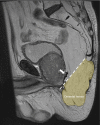Further insights into the treatment of perineal hernia based on a the experience of a single tertiary centre
- PMID: 31910492
- PMCID: PMC7318248
- DOI: 10.1111/codi.14952
Further insights into the treatment of perineal hernia based on a the experience of a single tertiary centre
Abstract
Aim: There is little evidence concerning the optimal surgical technique for the repair of perineal hernia. This study aimed to report on the evolution of a technique for repair of perineal hernia by analysing the experience in a tertiary referral centre.
Method: This was a retrospective review of consecutive patients who underwent perineal hernia repair after abdominoperineal excision in a tertiary referral centre. The main study end-points were rate of recurrent perineal hernia, perineal wound complications and related re-intervention.
Results: Thirty-four patients were included: in 18 patients a biological mesh was used followed by 16 patients who underwent synthetic mesh repair. Postoperative perineal wound infection occurred in two patients (11%) after biological mesh repair compared with four (25%) after synthetic mesh repair (P = 0.387). None of the meshes were explanted. Recurrent perineal hernia following biological mesh was found in 7 of 18 patients (39%) after a median of 33 months. The recurrence rate with a synthetic mesh was 5 of 16 patients (31%) after a median of 17 months (P = 0.642). Re-repair was performed in four (22%) and two patients (13%), respectively (P = 0.660). Eight patients required a transposition flap reconstruction to close the perineum over the mesh, and no recurrent hernias were observed in this subgroup (P = 0.030). No mesh-related small bowel complications occurred.
Conclusion: Recurrence rates after perineal hernia repair following abdominoperineal excision were high, and did not seem to be related to the type of mesh. If a transposition flap was added to the mesh repair no recurrences were observed, but this finding needs confirmation in larger studies.
Keywords: Perineal hernia; abdominoperineal excision; biological mesh; mesh repair; synthetic mesh.
© 2020 The Authors. Colorectal Disease published by John Wiley & Sons Ltd on behalf of Association of Coloproctology of Great Britain and Ireland.
Conflict of interest statement
The authors have no conflict of interest to declare.
Figures


Comment in
-
Getting to the 'bottom' of perineal hernias.Colorectal Dis. 2020 Jun;22(6):609-610. doi: 10.1111/codi.15142. Colorectal Dis. 2020. PMID: 32542905 No abstract available.
References
-
- Aboian E, Winter DC, Metcalf DR, Wolff BG. Perineal hernia after proctectomy: prevalence, risks, and management. Dis Colon Rectum 2006; 49: 1564–8. - PubMed
-
- Musters GD, Klaver CEL, Bosker RJI et al Biological mesh closure of the pelvic floor after extralevator abdominoperineal resection for rectal cancer: a multicenter randomized controlled trial (the BIOPEX‐study). Ann Surg 2017; 265: 1074–81. - PubMed
-
- So JB, Palmer MT, Shellito PC. Postoperative perineal hernia. Dis Colon Rectum 1997; 40: 954–7. - PubMed
-
- Habr‐Gama A, Sao Juliao GP, Mattacheo A et al Extralevator abdominal perineal excision versus standard abdominal perineal excision: impact on quality of the resected specimen and postoperative morbidity. World J Surg 2017; 41: 2160–7. - PubMed
-
- Sayers AE, Patel RK, Hunter IA. Perineal hernia formation following extralevator abdominoperineal excision. Colorectal Dis 2015; 17: 351–5. - PubMed
MeSH terms
LinkOut - more resources
Full Text Sources
Medical

